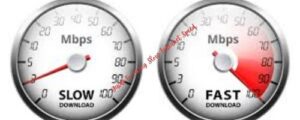Last Updated on May 1, 2024 by Daniel Osakwe
In today’s fast-paced world, slow internet can be a frustrating roadblock. Before you blame your Internet Service Provider (ISP), it’s crucial to ensure that your own network is not the culprit. In this blog post, I’ll guide you through a step-by-step process to troubleshoot and enhance your internet speed. I’m Daniel Osakwe, the tech enthusiast, and together, we’ll make your internet experience smoother. Let’s dive in!
Table of Contents
Boost Your Internet Speed: A Comprehensive Guide to Fixing Slow Internet Speed

Setting Expectations
First things first, it’s essential to understand that you won’t get more speed than what you’re paying for. If you’ve subscribed to a certain speed, you should aim to get as close to that as possible. Let’s clean up our own house before blaming the ISP.
Checking Hardware
To resolve slow internet speed, begin by inspecting your hardware setup – modem, router, and ISP’s equipment. Ensure that power and online lights are on. If not, power down the modem for five minutes to establish a fresh connection. Verify the router’s internet light; if it’s off, check and secure the LAN cable connecting it to the modem.
Router Configuration
Slow internet speed can also be caused by router misconfiguration. to resolve this, access your router’s settings, ensure both 2.4 GHz and 5 GHz networks are enabled, and verify that the settings are on automatic. This step ensures a stable connection between your devices and the router.
Windows Troubleshooting
On your windows computer, open the command prompt (CMD) and type “ipconfig” to check your network connectivity. If issues persist, use the Windows troubleshooter to guide you through potential fixes. Additionally, ensure that your network settings are set to automatic in the adapter options.
DNS Configuration
Check your router’s DNS settings, using the gateway IP address obtained earlier. Consider changing to a different DNS if needed. This step ensures your device correctly translates website addresses.
Connectivity Test
Perform a ping test to your router and Google’s servers to assess packet loss. Minimal or zero percent packet loss indicates a healthy connection. This step helps identify issues with your network card.
Antivirus and Malware Check
Regularly update and run antivirus scans to eliminate malware, which can significantly impact network speed. A compromised system may unknowingly participate in activities that slow down your internet connection.
Wired vs. Wireless Speed Test
Run speed tests using both wired and wireless connections. A significant difference may indicate issues with your device’s Wi-Fi capabilities. Consider upgrading your equipment if needed.
Mobile Speed Test
Run the same speed test on your mobile device to determine if the issue is isolated to a specific device or a broader network problem.
Contacting Your ISP
If all else fails, armed with the information gathered, contact your ISP. Provide them with the details of your troubleshooting and demand a resolution to ensure you’re getting the speed you’re paying for.
Conclusion
By following these steps, you can pinpoint and resolve issues that may be affecting your internet speed. Remember, a well-maintained network, up-to-date antivirus software, and regular checks can significantly contribute to a faster and more reliable internet experience. Don’t hesitate to demand the service you deserve from your ISP. If you found this guide helpful, share your thoughts in the comments below. For more tech tips and tricks, bookmark my website, and let’s keep the digital world running smoothly!



